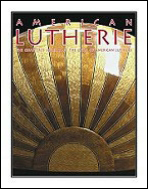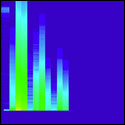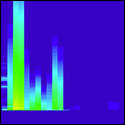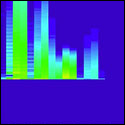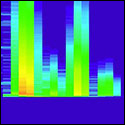|
||||||||
Four FFT Spectrograms by Alain Bieber
We have selected four basic FFT spectrograms out of the set of 24 FFT spectrograms made by the Onera Lab in their anechoic room in Toulouse. The purpose was to compare the Altho guitar #4 with the reference Gomez guitar, an instrument quite representative of the Madrid school. See American Lutherie #95. You will find, in what follows, the spectrograms relative to the open 4th string, D note with a fundamental main frequency of 147Hz. Other frequencies also showed differences, but we believe this one is the most illustrative. Along the x axis are represented the successive bands of frequencies for which a partial can be visualised. Along the y axis is represented the time. The sound intensity in dB for each band of frequency and along time, is represented by a scale of colour as indicated at the right of each diagram. A word of caution is relative to the time y axis because you will notice that such figures are showing the different time lags which existed between the opening of the mike and the excitation of the string for each recording. The excitation of the string was produced by the thumb nail with no particular effort to excite at a high level the string. See photo of the musician in the anechoic chamber. Small differences could have existed in the excitation between tests but we were told by specialised acousticians that it was not really a concern for a simple FFT test. In the diagrams labeled “other strings free,” we plucked the open D string and let the five other strings vibrate freely. In the diagrams labeled “other strings muted,” we have plucked the open D string and interposed between the fingerboard and the five other strings small shims of soft plastic to mute them. If we look at the two “muted” tests first, we see that the two instruments slightly differ on several points: 1. The fundamental (147Hz) is just a little bit more powerful for the reference instrument, but the sustain is slightly less than for the Al-Tho. 2. The first partial (294Hz) has more duration and has more depth for the Al-Tho than for the reference. 3. The second partial (440Hz) has a little more duration and depth than the Altho. 4. Higher frequency partials are more present in the reference instrument . Although you have to scrutinize to see it, the 880Hz can be seen to have a quite limited duration. The Al-Tho guitar produces fewer harmonics in such high frequencies. If we look now at the two "free strings" tests we see at first glance the same differences but with an amplfication, so to speak, for points 2 and 3 of the observation. The first stronger upper harmonic is the A440 for the Spanish guitar, in duration and intensity, and it is the D294 for the Al-Tho guitar. This is the main point revealed by this comparison. One can also note that high frequency partials can be found, if you scrutinize, for the reference instrument in the 1000Hz area and in the 1350Hz area. Even if really short and weak such harmonics can have some influence on the tone of the guitars making the Spanish one warmer (but remember, it is a cedar top) and a bit more “nasal” I think. The technical conditions of the FFT tests as conducted in Toulouse are as follows: The name of this basic test is due to the way the signal is analysed through a decomposition in Fourier series. FFT stands for “Fast Fourier Transform.” This basic technique is often used in musical acoustics, but I have been told that the weakness is its relative lack of precision in the few milliseconds after the attack. This moment is paramount in the making of the sound tone or timbre of each instrument. |
||||||||
Top of Page |

